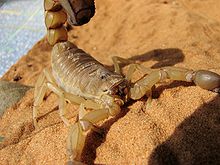Androctonus australis
| Androctonus australis | |
|---|---|

| |
| Scientific classification | |
| Domain: | Eukaryota |
| Kingdom: | Animalia |
| Phylum: | Arthropoda |
| Subphylum: | Chelicerata |
| Class: | Arachnida |
| Order: | Scorpiones |
| Family: | Buthidae |
| Genus: | Androctonus |
| Species: | A. australis
|
| Binomial name | |
| Androctonus australis | |
Androctonus australis, the yellow fat-tailed scorpion, is a hardy desert scorpion from North Africa, Somaliland, the Middle East, Pakistan and India.
Hardiness
Unlike most other animals that live in deserts, Androctonus does not dig burrows to protect itself from a sandstorm. Instead, it can withstand sandstorms powerful enough to strip paint off steel, without any apparent damage. The resistance of Androctonus to sandstorms is suspected to be due to its unusual exoskeleton surface texture. Its armor is covered with dome-shaped granules that are 10 μm (0.0004 in) high and 25–80 μm (0.0010–0.0031 in) across. When this surface texture is translated into other materials it protects them to a certain degree as well, which has led to the possibility of the applicability of imitation surfaces in such objects as aeroplanes and helicopters.[2]
Etymology
The name Androctonus australis is derived from the Greek word Androctonus (roughly translated as "man-killer") and the Latin word australis (translated as "south") which together translate as "southern man-killer".
Description and behavior
Androctonus australis is a medium-sized scorpion which can grow up to 10 centimeters in length. It has a very thick and powerful tail,[3] and stripes on the sides of its dome for better vision while attacking another animal or for the use of self-defense. It is an animal of nocturnal habit, during the day it hides in humid and dark places, while the night goes out to hunt, it feeds on insects, small lizards and even small mammals. Cannibalism has been reported in this species. It is found mainly in deserts and arid places.[4]
Toxicity
Androctonus australis has very potent venom[5] and is one of the world's most dangerous scorpions due to its relative toxicity and temperament. It claims several lives each year.[3] It has the most potent venom of its kind, it is mainly composed of neurotoxins, cardiotoxins and myotoxins and additional hemotoxins, deaths in humans usually occur by heart and respiratory failure, sometimes by cerebral hemorrhage, organ dysfunction and shock.[4] The LD50 for this species is 0.32 mg / kg subcutaneously.[6]
The AaTX1 toxin was originally found in the venom of Androctonus australis.
See also
References
- ^ Benjamin Gantenbein & Carlo R. Largiadèr (2003). "The phylogeographic importance of the Strait of Gibraltar as a gene flow barrier in terrestrial arthropods: a case study with the scorpion Buthus occitanus as model organism" (PDF). Molecular Phylogenetics and Evolution. 28 (1): 119–130. doi:10.1016/S1055-7903(03)00031-9. PMID 12801475. Archived from the original (PDF) on 2005-01-16.
- ^ "Not a scratch: scorpions may have lessons to teach aircraft designers". The Economist. February 4, 2012. Retrieved November 12, 2012.
- ^ a b "The Scorpion Files - Androctonus australis (Buthidae)". Ntnu.no.
- ^ a b "Living Hazards Database (LHD) – Search by Scientific Name" (PDF). Acq.osd.mil. Archived from the original (PDF) on 2 July 2017. Retrieved 16 March 2022.
- ^ Steve Backshall (2011). Venom: Poisonous Animals in the Natural World. New Holland Publishers. p. 96. ISBN 978-1-84773-870-7.
- ^ "LD50 table". Members.tripod.com. Retrieved 2020-10-20.
External links
 Media related to Androctonus australis at Wikimedia Commons
Media related to Androctonus australis at Wikimedia Commons